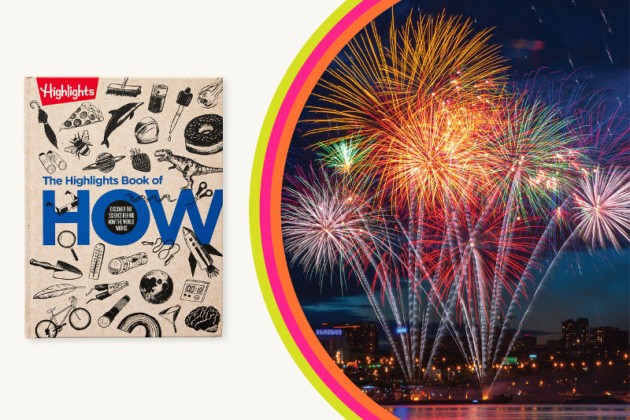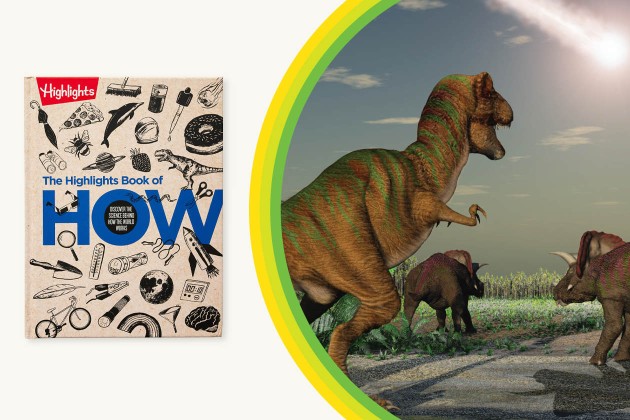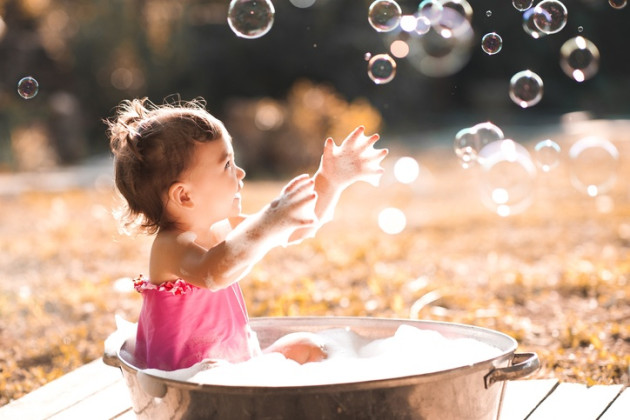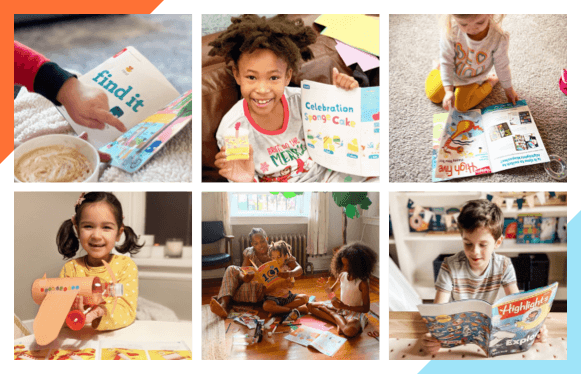“Book of How” Excerpt: How to Make Fireworks in a Glass
By: Highlights Editorial
Historians think the first-ever fireworks were created about 2,000 years ago in China, when people tossed bamboo sticks onto a fire and they exploded. Bamboo has segments that contain water and other substances. When the bamboo is heated, these materials also get hot and vaporize or convert to a gas. With continued heating, the gas trapped in the bamboo compartment expands, and eventually the bamboo compartment violently explodes, creating a loud noise.
According to legend, Chinese scientists trying to make a potion for immortality accidentally invented an explosive powder around the year 800. This powder—a blend of different chemicals and substances—is still used in fireworks today. People who make fireworks shape the powder, sometimes called black powder, into hard pellets known as stars. They also mix in different chemicals and metals. Firework designers put these stars into containers called shells.
Then, extra black powder is packed into another part of the shell. This powder is ignited, or set on fire—and it explodes! However, this explosion is controlled through a fuse so that the firework does just what it’s meant to. When the powder explodes, hot air pushes against the ground, shooting the firework into the sky.
Meanwhile, the fuse keeps burning. The designers time it so that right about when the firework is as high as it will go, the burning fuse reaches the stars, and a second explosion happens. This explosion is much larger and—thanks to the metal and chemicals in the stars and how the stars are arranged in the shell— creates amazing colors and shapes, going out with a bang.
Fun Facts:
Not only do the people who make fireworks design them to have certain shapes and colors, they also design them to explode with certain sounds. This is why some fireworks sizzle, others crackle, and some even whistle. Some people are even designing quiet fireworks so that pets and people nearby who hear them won’t be startled.
Fireworks make use of substances that have sodium, copper, and other metals that burn different colors after they are launched into the sky. Sodium, a major part of salt, burns yellow when exposed to heat. Copper burns bluish green, and lithium mixed with other chemicals makes a reddish color when it burns.
How to Make Your Own Fireworks in a Glass
Reds, blues, yellows, and greens—fireworks light up the sky during celebrations. You can’t make your own fireworks, but you can reproduce their cool colors and shapes in this activity.
What You’ll Need:
- Tall glass
- Water
- Small clear bowl
- Vegetable oil
- Food coloring
- Fork
What You’ll Do:
1. Fill the glass with about three-fourths full with warm water.
2. Fill the small bowl with oil. Put 5-6 drops of food coloring into the oil. Observe what happens.
3. Use the fork to stir the oil until the food coloring is broken into small drops. 4.
Pour the oil slowly into the glass of water. Watch and observe what happens.
How It Works:
Food coloring is mostly water, and water and oil don’t mix. Instead of dissolving in the oil, the food coloring stayed in droplets, even when you stirred them. When you poured the oil and food coloring into the warm water, the oil started to float. That’s because oil is less dense than water. It didn’t just float on the warm water in the glass . . . it also floated on the watery food coloring, pushing those droplets to the bottom. Once the food coloring droplets touched the water, though, they fell apart, making firework-like patterns as they fell to the bottom of the glass.
Extend the Fun:
Kids can decorate confetti poppers, and then “set them off.” This activity is a great way to keep kids entertained during a backyard barbecue, on New Year’s Eve or before the local Fourth of July parade starts!
Did you love this excerpt from page 282 of our new Book of How? With 352 pages of experiments, activities and answers to kids’ questions, the new Book of How is a perfect gift for inquisitive kids.









